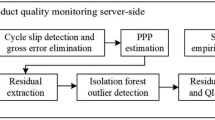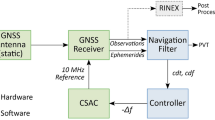Abstract
Temporal correlation in network real-time kinematic (RTK) data exists due to unmodeled multipath and atmospheric errors, in combination with slowly changing satellite constellation. If this correlation is neglected, the estimated uncertainty of the coordinates might be too optimistic. In this study, we compute temporal correlation lengths for network RTK positioning, i.e., the appropriate time separation between the measurements. This leads to more realistic coordinate uncertainty estimates, and an appropriate surveying strategy to control the measurements can be designed. Two methods to estimate temporal correlation lengths are suggested. Several monitor stations that utilize correction data from two SWEPOSTM Network RTK services, a standard service and a project-adapted service with the mean distance between the reference stations of approximately 70 and 10–20 km, are evaluated. The correlation lengths for the standard service are estimated as 17 min for the horizontal component and 36–37 min for the vertical component. The corresponding estimates for the project-adapted service are 13–17 and 13–16 min, respectively. According to the F test, the proposed composite first-order Gauss–Markov autocovariance function shows a significantly better least-squared fit to data compared to the commonly used one-component first-order Gauss–Markov model. A second suggested method is proposed that has the potential of providing robust correlation lengths without the need to fit a model to the computed autocovariance function.






Similar content being viewed by others
References
Bjerhammar A (1973) Theory of errors and generalized matrix inverses. Elsevier, Amsterdam, London, New York
Emardson R, Jarlemark P, Bergstrand S, Nilsson T, Johansson J (2009) Measurement accuracy in network-RTK. SP Sweden Technical Research Institute and Chalmers Technical University. SP report :23
GUM (1994) Guide to the expression of uncertainty In Measurement. international organization of standardization, 1st edn. Geneva Switzerland, Corrected and reprinted 1995
Howind J, Kutterer H, Heck B (1999) Impact of temporal correlations on GPS-derived relative point positions. J Geod 73(5)
Kjørsvik N (2002) Assessing the multi-base station GPS solutions. FIG XXII International Congress, April 19–26, Washington D.C. USA
Odolinski R (2010) Swedish user guidelines for network RTK. In: proceedings of the XXIV FIG International Congress, Sydney, 2010
Teunissen PJG, Amiri-Simkooei AR (2008) Least-squares variance component estimation. J Geod 82
Tiberius C (2001) A univariate analysis of the impact of time correlation. Boll Geod 60(1):33–48
Vollath U, Landau H, Chen X, Doucet K, Pagels C (2002) Network RTK versus single base RTK—understanding the error characteristics. In: ION GPS 2002, Portland, USA, Sept. 24–27, 2002
Acknowledgments
The author wants to thank the editor and two anonymous reviewers for the constructive comments and suggestions, significantly improving the quality of this paper. A further acknowledgment is given to Professor Clas-Göran Persson at the Royal Institute of Technology (KTH) and Geodetic Research Department of Lantmäteriet (Swedish mapping, cadastral and land registration authority) for the invaluable suggestions improving the contents of the paper.
Author information
Authors and Affiliations
Corresponding author
Rights and permissions
About this article
Cite this article
Odolinski, R. Temporal correlation for network RTK positioning. GPS Solut 16, 147–155 (2012). https://doi.org/10.1007/s10291-011-0213-0
Received:
Accepted:
Published:
Issue Date:
DOI: https://doi.org/10.1007/s10291-011-0213-0




